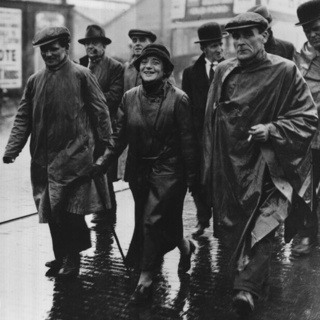
127. Master class. In opposition. And opportunism
It’s time for a master class in opposition by the man who said that the role of the Opposition is to oppose. Disraeli and Gladstone, both now leaders in the House of Commons of the Liberal and Conservative parties respectively, faced off over electoral reform. And Disraeli displayed real genius in outflanking Gladstone, first to defeat him by opposing reform when the Liberals proposed it while they were in government, and then by backing it when the Conservatives took over and proposed their own legislation. So a glorious example of opportunism pursued with dazzling skill in the pursuit of power. Illustration: Dishing the Whigs, from the magazine Fun Lord Derby (left) andn Disraeli (right) have dished their Whig (Liberal) opponents by introducing a reform measure more liberal than they had. The two Conservative leaders now present the heads of the Liberal leaders to Queen Victoria. Music: Bach Partita #2c by J Bu licensed under an Attribution-NonCommercial-No Derivatives (aka Music Sharing) 3.0 International License.
29 Jan 202314min

126. Helping the poor. But not too much
The American Civil War, like the war led by Prussia against Denmark, showed that Britain was no longer the superpower that had emerged from the Napoleonic wars. In both those conflicts, Britain had views – rather changeable ones, switching from one side to the other, in the American case – but couldn’t influence the outcome. Instead, Palmerston’s government could do little more than watch events take their course. What the American war also demonstrated, however, was how British workers, in particular the workers put through great hardship by the Lancashire Cotton Famine the war had precipitated, could put principle above personal interest. Despite the pain they were suffering, they had called on President Lincoln to go right on prosecuting the war until the defeat of the South and the emancipation of the slaves. Now, that didn’t loosen any purse strings. For some more decades, relief for people who needed help would continue to mean the Poor Laws with the workhouse in the background, and whatever voluntary help people felt they could spare. However, at a time when the question of extending the right to vote was re-emerging, the principled behaviour of the Lancashire workers encouraged those backing such a move, by revealing that artisans too could reach mature, even admirable, political judgements. But the atmosphere wasn’t right in parliament yet. Besides, Palmerston was still opposed to electoral reform at least in the short term. However, when he died, and he was the last British Prime Minister to die in office, he opened the door to that debate again. Which will be the subject of our next episode. Illustration: Prince Albert and Queen Victoria in 1859, by George Milner Gibson Jerrard, after Frances Sally Day. National Portrait Gallery x197484 Music: Bach Partita #2c by J Bu licensed under an Attribution-NonCommercial-No Derivatives (aka Music Sharing) 3.0 International License.
22 Jan 202314min

125. King Cotton and his Lancashire Famine
After talking last week about wars in China and Italy, and potentially with France, in this episode we turn to the United States where one of the biggest wars of the nineteenth century was just breaking out. That was the American Civil War. We’ll see how the secessionist southern, slaveholding states, soon to call themselves the Confederate States of America, made a disastrous miscalculation, by blocking their own exports of cotton. It was a lethal self-inflicted wound, but it also caused terrible hardship in Britain where the textiles and its feeder industries had become the nation's biggest employer. Britain remained divided over the war, with many in government, including three of the most important ministers, Palmerston, the Prime Minister, Russell, the Foreign Secretary, and Gladstone, the Chancellor of the Exchequer, favoured the South. Indeed, at one point it looked as though Britain might well get involved in the war against Abraham Lincoln’s Union side. In the end, though, Britain remained neutral. One of the contributory factors had to be the extraordinarily courageous, and self-sacrificing, behaviour of the people in Lancashire who were suffering the most from the cotton embargo. When Lincoln turned the war into one against slavery, they met and wrote to urge him to keep up the fight, despite the suffering it was causing them, until the Confederates were defeated, and the slaves freed. And they even got back a reply from the President with a tribute to their spirit. Illustration: Francis Bicknell Carpenter, First Reading of the Emancipation Proclamation (detail). Public Domain. Lincoln is on the left, Seward the seated figure to the right. Music: Bach Partita #2c by J Bu licensed under an Attribution-NonCommercial-No Derivatives (aka Music Sharing) 3.0 International License.
15 Jan 202314min

124. The tide begins to ebb
When the Earl of Derby’s second government fell, Victoria tried to impose a Prime Minister of her choice on the elected politicians who felt rather differently. That, though, was obsolete thinking. In the end she had to take Palmerston back. He was now 75, though as ready for hard work as ever. He faced a number of foreign affair challenges, most of them wars. A war with China to complete successfully on behalf of drug pushers. A war to avoid with France, which he did with a little help from two non-ministers, Richard Cobden in Britain and Michel Chevalier in France. A war in Italy. A German war against Denmark. One big lesson was that the days when Britain could dictate terms to its neighbours and get its way, were gone. If any country was going to be able to play that game, the experience of Denmark showed it would be more likely to be the Germany Prussia aspired to build and lead. Britain might not have seen it yet, but the writing was on the wall for its global military power, which was beginning to ebb. Meanwhile, another war was raging across the Atlantic. It too would have a major impact on Britain. But that’s for next week. Illustration. Henry John Temple, third viscount Palmerston, in later life, by Francis Cruikshank National Portrait Gallery 3953 Music: Bach Partita #2c by J Bu licensed under an Attribution-NonCommercial-No Derivatives (aka Music Sharing) 3.0 International License.
8 Jan 202314min

123. Dizzy times
This week we’re into Dizzy times again. Disraeli, or Dizzy as he came to be known, had played a leading role in bringing down the Palmerston government in 1858. That allowed the Earl of Derby, leader of the Conservatives, to form his second administration. With Derby in the Lords, responsibility for managing the government’s affairs in the Commons fell to Dizzy, as Leader of the House of Commons, and he also became Chancellor of the Exchequer again. The Derby government brought in the legislation that ended the East India Company’s rule in India, replacing it by direct rule from London and launching the British Raj. Next, Disraeli picked up the cause of electoral reform, surprisingly for a Conservative. He realised, as few in his party had, that extending the vote might actually benefit the Conservatives, and that there was no inevitability to artisans voting Liberal. But the reform proposals failed as the Liberals, finally getting their act together, rallied enough force to defeat the government, and then did it again following a general election in which the Conservatives did well but not well enough to win an outright majority. The second Derby government had lasted sixteen months, barely more than the ten months of the first. And Dizzy had to move back into Opposition. Illustration: Benjamin Disraeli, photo from the early 1860s, printed by Henry Lenthall, after William Edward Kilburn. National Portrait Gallery Ax46252. Music: Bach Partita #2c by J Bu licensed under an Attribution-NonCommercial-No Derivatives (aka Music Sharing) 3.0 International License.
1 Jan 202314min

122. Events, dear boy, events
After discussing his relative success with a moderately liberal programme in England last time, in this episode we talk about Palmerston’s far greater difficulties abroad. There was another Opium War in China, as Britain fought to enforce the East India Company’s right to push drugs there, and then an uprising in India, which Brits still like to think of as a mutiny though many Indians see it as a War of Independence. Both events involved extensive brutality, most of it by Britain, but Palmerston did just fine in the debates on both. The stumbling block proved to be something far less significant: a terrorist outrage in Paris by a man who’d had some connection with England. The French demanded that Palmerston take action, and he responded by proposing new legislation. That had seemed to many like kowtowing to the French, and the Opposition in parliament was able to engineer a victory in a vote against his government’s behaviour. Oddly, that was on the very night after his victory over military action in India. One evening, he was victorious, the next he was out. Events, you see, events are the real killers in a statesman’s existence. Illustration: Sepoy Mutiny, 1857 by Charles Granger, showing a scene from the 1857 Indian uprising. From Wikimedia Commons. Music: Bach Partita #2c by J Bu licensed under an Attribution-NonCommercial-No Derivatives (aka Music Sharing) 3.0 International License.
25 Dec 202214min

121. After Crimea
After the signing of the Treaty of Paris, the troops came home from Crimea, as did the remarkable women we talked about last week: Mary Seacole and Florence Nightingale. They came back to different lives: Nightingale went on to do seminal work in nursing and in healthcare analysis – she revealed an unusual grasp of mathematical methods and became the first female member of the Royal Statistical Society – while Seacole faced bankruptcy and closed doors. Could that be down to her blood running, as she put it, “under a duskier skin” than that of most Brits? Before we finally leave Crimea, this episode includes a quick digression about another remarkable healthcare specialist, this time on the Russian side, the military surgeon Nikolay Pirogov. Then, like the troops, we return to England. There Palmerston was pursuing a liberal domestic policy programme, but as we’ll explore more next week, he was about to encounter events in foreign affairs that would put a spoke in his wheels. Illustration: Detail from Diagram of the causes of mortality in the army in the East (1858) by Florence Nightingale, a coloured pie chart to illustrate causes of death in the British Army. Public domain in its source country on January 1, 1996 and in the United States. Music: Bach Partita #2c by J Bu licensed under an Attribution-NonCommercial-No Derivatives (aka Music Sharing) 3.0 International License.
17 Dec 202214min

120. Two remarkable women
Mary Seacole, Jamaican and Mixed Race, and Florence Nightingale, White and from the English middle class, both in different ways did extraordinary work in Crimea as nurses. They both opened the doors to a different kind of nursing, in which practical steps such as good hygiene was vital, alongside a caring attitude towards patients. The two met but never worked together. For the kind of radical change in nursing they ushered in, both showed the necessary qualities to an impressive extent. However, Seacole found that the authorities, and even Nightingale herself, made it far harder for her to be allowed to give all she could to the sick and wounded of Crimea. Which makes it hard not to ask, as she did, whether it might not be because her “blood flowed beneath a somewhat duskier skin than theirs”. Illustration: Mary Seacole by Albert Charles Challen, National Portrait Gallery 6856 (image reversed left-to-right), and Florence Nightingale by Jerry Barrett, National Portrait Gallery 2939 Music: Bach Partita #2c by J Bu licensed under an Attribution-NonCommercial-No Derivatives (aka Music Sharing) 3.0 International License.
11 Dec 202214min





















